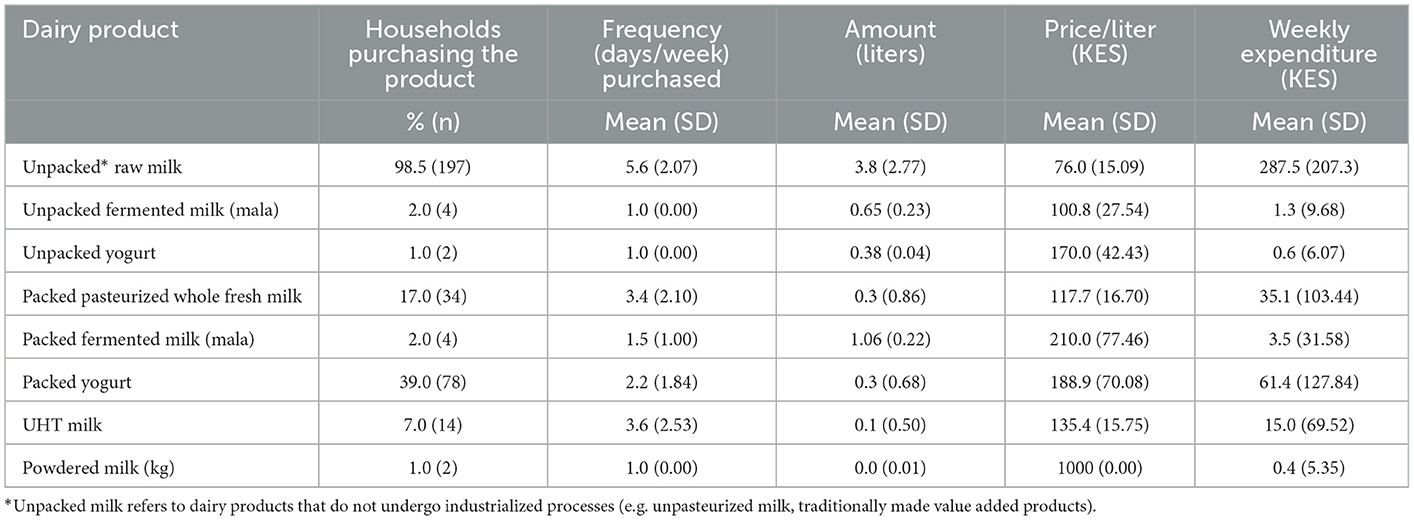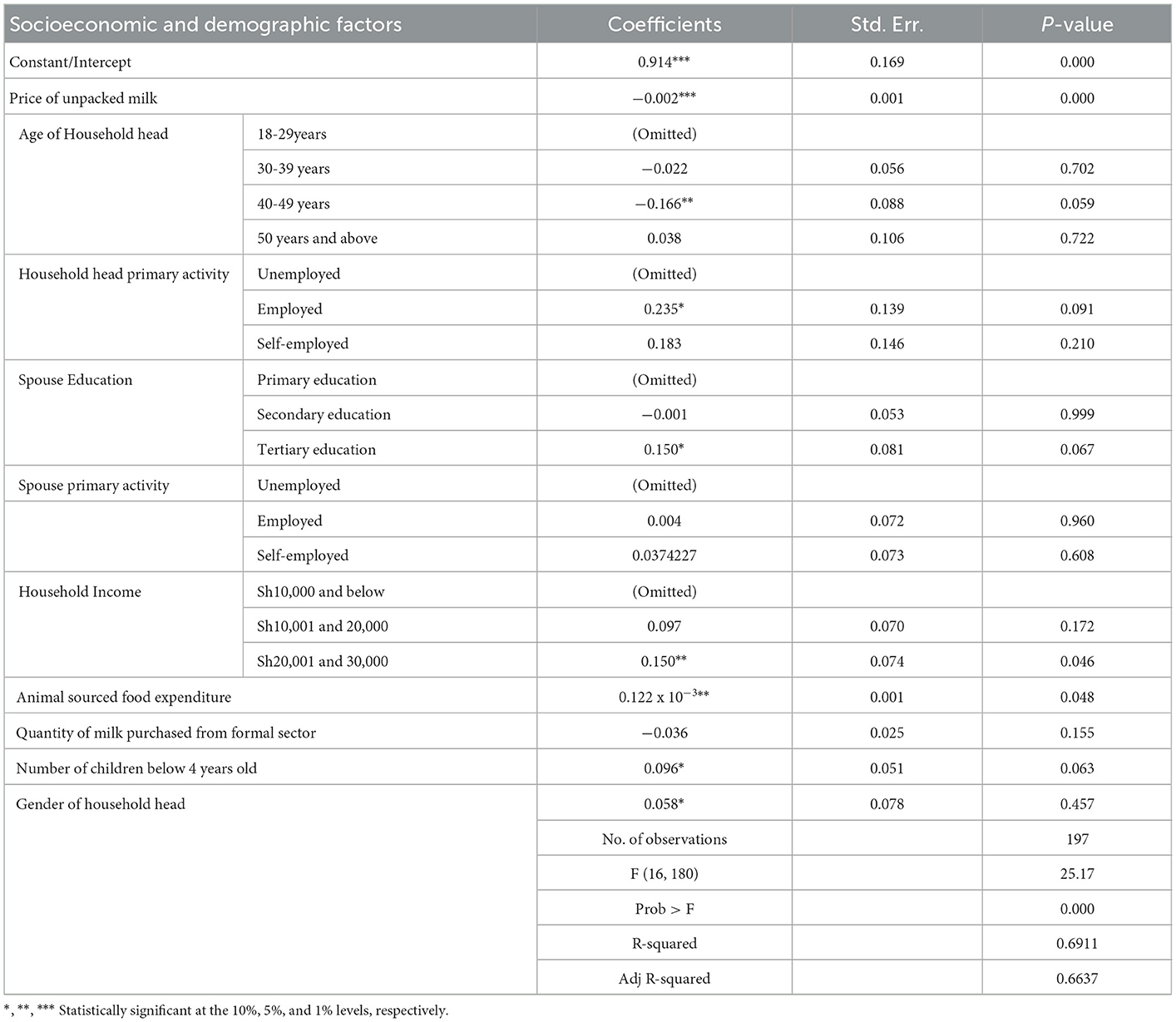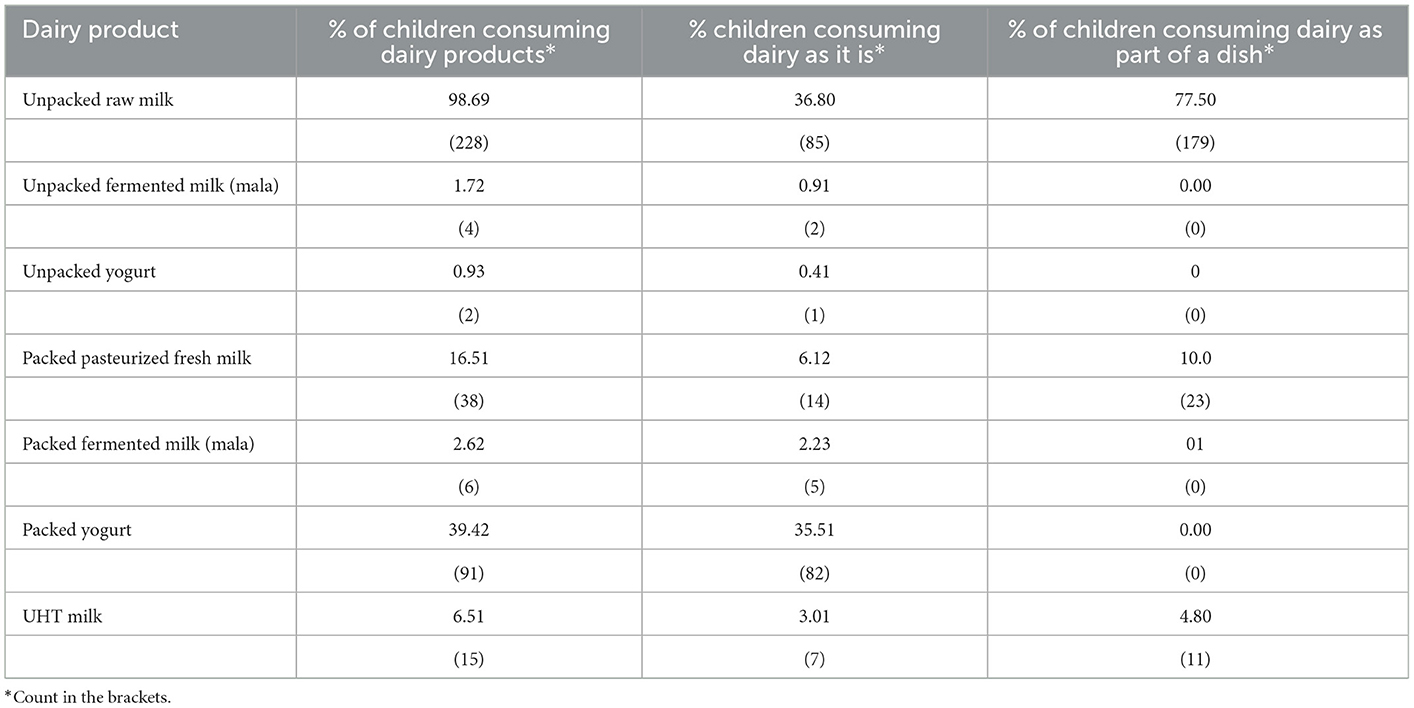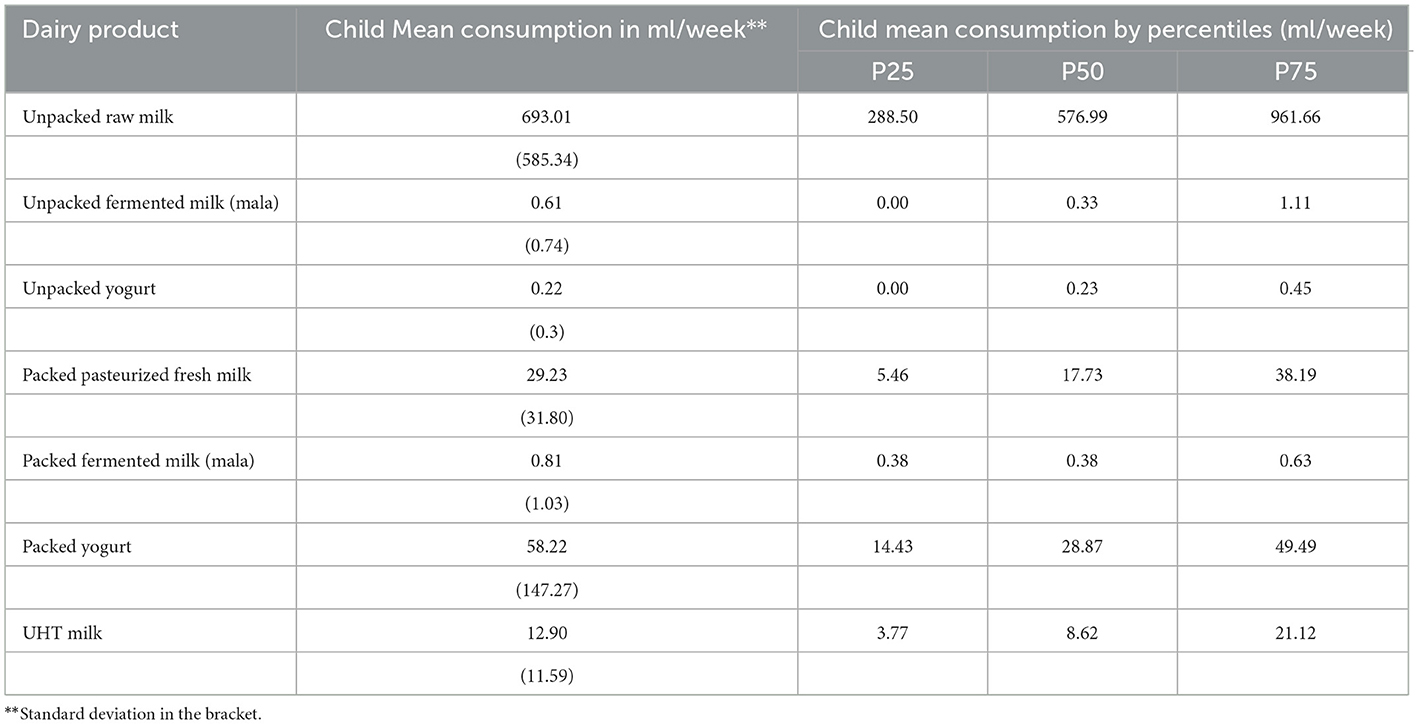- 1Animal and Human Health Program, International Livestock Research Institute, Nairobi, Kenya
- 2Department of Agricultural Economics, School of Agribusiness and Enterprise Development, Kenyatta University, Nairobi, Kenya
- 3Strategy and Knowledge Department, International Fund for Agricultural Development, Cairo, Egypt
- 4Animal and Human Health Program, International Livestock Research Institute, Addis Ababa, Ethiopia
Milk plays an important role in the growth and development of children. In Kenya, it is one of the most produced and consumed animal-sourced foods, but often consumed in small amounts among children of low-income families, especially in urban settings. The aim of the study was to identify household milk purchase and consumption patterns of milk, with emphasis on young children, as well as estimate key determinants of such patterns to identify areas of leverage to increase milk consumption. Results showed that 98% of households purchased unprocessed fresh milk at least once during the 7 days prior to the survey, while only 17% purchased packed pasteurized milk. Findings from the Ordinary Least Squares (OLS) model of purchase behavior suggest that the amount of unpacked milk purchased by households is positively and significantly related to household income, the number of children below the age of 4, and the budget of animal-sourced food. The price and quantities of pasteurized milk purchased were negatively related to the amount of unpacked milk purchased. Consumption patterns for children below the age of 4 showed that milk and dairy products are most commonly consumed as part of dishes than as individual products. Informal markets played a key role in meeting the milk needs of children, but consumption was below recommended amounts. The clear association of income and milk intake calls for efforts from the government to support the dairy sector with policies that promote the availability and affordability of milk, especially for a sector that feeds low-income families, as it is the case with the informal dairy markets.
1. Introduction
Milk plays a key role in early childhood development and contributes to food and nutrition security. In Kenya, it is a vital component of people's diets and a major source of animal protein (Dror and Allen, 2011). Milk consumption contributes to cognitive development, and it has been associated with reduction of dental caries, risk of high blood pressure, stroke, and heart disease (Bus and Worsley, 2003; Lönnerdal, 2003). Milk and dairy products contain various vital nutrients such as calcium, vitamins, potassium and sodium. Calcium is essential for healthy bone density and therefore a basic nutrient for preventing osteoporosis (Wham and Worsley, 2003). Vitamin D helps absorption of calcium, and vitamin A is essential for maintaining healthy vision (Black et al., 2002). Milk is therefore one of the most nutrient dense foods. Additionally, relative to other animal sourced foods, it is one of the most affordable and accessible for children in Africa (Grace et al., 2018).
Kenya is ranked as one of the biggest producers of milk in Africa. Kenya is also one of the countries with highest annual per capita consumption of milk in sub-Saharan Africa, estimated to be 110 liters (Rademaker et al., 2016), representing approximately an average of 300 ml per capita per day. However, this falls short of the widely recommended annual per capita consumption of 220 liters (FAO, 2011). It is also below the recommended quantity of about 500 ml (2 cups) per child per day for children above age of 1 year (MoH, 2020). Based on existing data, the Kenya Dairy Board (KDB), the government agency that regulates and promotes the dairy sector in the country, anticipates a rate of growth of milk consumption of 5.8% due to increasing urbanization, rising middle class and regional milk exportation opportunities (MoALF, 2013; Gichohi, 2014; KDB Milk Intake, 2022).
Despite the significant GDP contribution by the Kenyan dairy sector, and the estimated growth patterns indicating great potential for increasing production and consumption, there are various challenges from the upstream (production) to the downstream (consumption) end of the Kenyan dairy value chain. For instance, according to KDB (2014), only 55% of total production is sold at farm gate or beyond, with the rest consumed at the farm or given to calves (KDB, 2014; Rademaker et al., 2016). Of the amount marketed, the bulk of it (over 85%) is sold unprocessed (i.e., unpacked1 and mostly unpasteurized) in informal dairy markets (FAO, 2011; Gichohi, 2014; KDB, 2014).
Whereas the informal dairy markets offer affordable and accessible milk to middle and low-income households – they market unprocessed milk, cheaper than the processed milk, and sold in different quantities depending on consumer's affordability – such marketing channels are often operating at the margins of regulations (Nyokabi et al., 2021). This informal sector is deemed by the regulatory authorities to pose food safety and quality concerns, as it largely operates unregulated (Alonso et al., 2018; Kangethe et al., 2020; Muunda et al., 2021; Nyokabi et al., 2021). Such concerns are valid as they influence the global disease burden (Grwambi, 2021). However, the role of informal markets in food supply and nutritional security for the urban economically underprivileged and as a source of livelihood for smallholder producers and retailers cannot be ignored while addressing such concerns (Roesel and Grace, 2014; Apaassongo et al., 2016).
Due to the above challenges, the Kenyan government, dairy development, and regulatory agencies have over the recent years designed policies and development interventions aimed at streamlining the sector, in terms of safety and quality regulations, and promoting milk consumption among Kenyans. Often, such interventions advocate for the elimination of the informal dairy marketing channel, which has the largest market share, in favor of the formal dairy markets, encouraging consumers to buy processed milk or adopting punitive approaches on the informal sector operators. This step has been taken by other developing countries like South Africa (Agenbag et al., 2012), Tanzania (URT, 2007), Rwanda and Uganda (EPRC, 2012).
As well intentioned as such policies may be, previous studies looking at their impact have hardly shown improvements on food safety (Leksmono et al., 2006; Kaitibie et al., 2010). A recent study also showed that such policy intervention affects the amount of milk low-income households allocate to children and reduced general intake in the household (Muunda et al., 2021). In order to develop policies that improve food safety and maximize public health without compromising nutritional outcomes, policy makers in low- and middle-income countries need evidence on the contribution of the informal dairy markets to the milk needs of households and what factors influence dairy consumption in those households (Cornelsen et al., 2016; Dominguez-Salas et al., 2016).
Given the nutritional value of milk, and the role that informal markets play in meeting the nutritional demands of low-income households, this information would help development of more responsive regulatory policies that are meant to address food safety and quality concerns, while preserving the role of the dairy sector to support nutrition security in low- and middle-income countries. An in-depth understanding of the milk purchase and consumption patterns is important not only for food policy formulation but also in the design of successful dairy sector development interventions. Also, given Kenya's relatively low per capita milk consumption, characterizing factors associated with milk purchasing and consumption patterns can help in identifying market expansion opportunities. This study therefore aims at revealing insights into household milk purchase and consumption patterns of milk, with emphasis on young children, as well as estimate the key determinants of such purchase and consumption patterns.
2. Materials and methods
2.1. Data collection
The study uses cross-sectional data collected in Dagoretti region (including Dagoretti North and South sub-counties) between April and June 2017. The study area is a peri-urban setting characterized by low-income households and informal settlements with limited agricultural production. The study included 200 households identified through randomly selected geospatial random points generated by ArcGIS 10.4.1. Inclusion criteria entailed households that purchased milk from informal milk markets and had at least one child between the age of 6–48 months. The targeted sample included an age group for which feeding, and nutrient intake, is critical for growth and development, while offering a window to capture different milk feeding practices in children of various ages among peri-urban dwellers. For the purposes of this study, a household was defined as a group of people that take food from the “same pot” (economic basket). A household member was someone who had eaten in the household for at least 6 months preceding the survey date, and at least half of the week in each week in those months, and at least one of the two main daily meals. Additional details are also available in Muunda et al. (2021) and as Supplementary material.
A structured questionnaire was developed on open data kit (ODK) system, pretested, and revised to collect data on 7-day household's purchase of milk and other dairy products, milk consumption by each household member, and perceptions on milk quality and safety. The survey also included questions on household income and expenditure, and demographic characteristics like household size, composition, household members' age, occupation, and educational level.
2.2. Data analysis
Data was extracted from ODK aggregate server, processed, and analyzed using STATA version 15.1. Descriptive statistics were generated for variables of interest such as household purchases and individual consumptions of milk and dairy products. Pairwise statistics and test of independence were used to investigate the effects of household demographic and socioeconomic characteristics on consumers' milk purchase and consumption patterns. The results are presented using descriptive statistics, tables, and graph illustrations.
2.3. Model estimations
Ordinary Least Squares (OLS) model was used to estimate the extent to which the household characteristics influenced the quantity of milk household i purchased from informal markets. We regressed the quantity of milk purchased from the informal market (unpacked milk) as a function of socioeconomic and demographic characteristics of the households. The rationale behind focusing on the informal market is the overall bigger share that it commands in the dairy sector, and any intervention in it would affect not only the market performance of the sector but also the nutrition needs of households significantly. These models are appropriate in describing the purchase and consumption behavior when households are faced with a variety of goods with a common consumption objective and under constraint budgets. Therefore, the average amount of milk purchased by a household, and amount allocated to a child below 4 years in the ith household will be determined as (Sichilima et al., 2015):
Where:
Qi is the average amount of unpackaged milk purchased
Yi is the household income level
HHi is the size of the household
Gi is the gender of the household head
Pi is the price of milk purchased
Educi is the education level of the household head
Zi a set of the other socioeconomic and demographic factors for the ith household like, age of the household head, number of children below 4 years, education level of spouse etc.
3. Results and discussion
In this study, <1 in five of the households interviewed were female headed, and most of these were single parent households. Average household size was four members. Two thirds of household heads were over 30 years old, and half had attained at least secondary education. Employment rate was high, with most household heads having a job. Moreover, in 40% of the households, the spouse was also engaged in a remunerated activity. Table 1 shows a detailed summary of the socioeconomic and demographic characteristics of the study sample.
3.1. Low-income households milk purchase patterns
All the households purchased milk from informal markets on regular basis, as per the selection inclusion criteria. Almost all surveyed households had purchased milk from these markets at least once in the 7 days prior to the visit and, those few who had not purchase milk in the previous 7 days, declared consuming milk from their own dairy animals. Only 17% had purchased packed pasteurized milk. Table 2 shows a summary of the average amounts of milk and dairy products purchased in the 7 days prior to the visit, mean weekly expenditure and frequency of purchase. Average price per liter increased with increased processing of dairy products, with raw unprocessed milk costing the cheapest and powdered milk, followed by packed fermented milk, being the most expensive. Unsurprisingly, the average amount of dairy products purchased by families decreased as the level of processing and industrialization of the products increased, and hence its price, increased.
Figure 1 shows the household dairy weekly purchase patterns by income category. For most products, the weekly amounts purchased differed across income groups, with purchase being lower in lower income households (USD ≤100/month). Generally, 98.5% of the households purchased unpacked raw milk at least once in a week compared to other dairy products. This could possibly be due to our selection criteria that required households to be primarily purchasing milk from informal markets, and also based on the fact that raw milk is cheaper compared to the rest of dairy products.
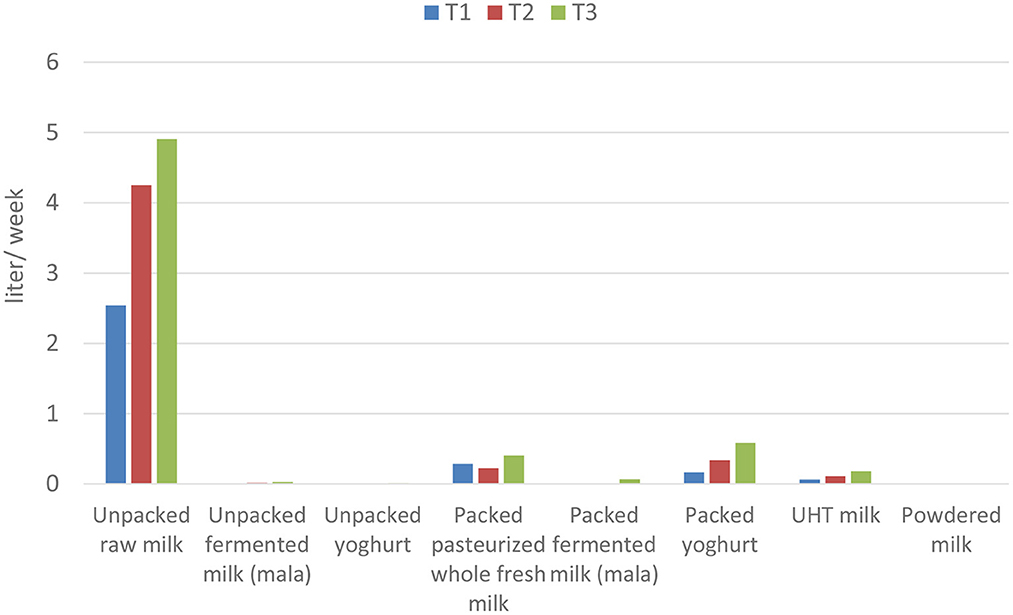
Figure 1. Household mean weekly purchase of dairy products, by income group. T1 = Lowest income group (<100 USD/month), T2 = Middle income group (101–200 USD/month), T3 = Highest income group (201–300 USD/month).
An in-depth analysis of the amount of milk purchased from informal markets indicated that there were statistically significant variations across various socioeconomic and demographic factors of the households. Table 3 shows statistical associations between the quantity of milk purchased from informal markets and household characteristics. Pairwise comparisons of average milk purchased from the informal markets revealed that there was a statistically significant difference between the mean weekly purchase of the lower income tier (below 100 USD) vs. the higher income tier (201–300 USD) (p < 0.001) and a marginal statistically significant difference across gender of the household head (p < 0.07). There were no statistically significant differences from the pairwise comparison of education level of the household, primary activity and education level of the spouse and marital status of the household head (data omitted and not included in Table 3).

Table 3. Comparison of average amount of milk purchased from informal markets over 7 days across socioeconomic and demographic groups.
3.2. Factors that influence households' milk purchase
Table 4 reports that milk price, number of children in the household below 4 years, budget of animal source foods and household income were found to be key determinants of the quantity of milk purchased per week from the informal markets. The difference in the quantities purchased by households with head aged between 40 and 49 years old from the reference age (18–29) was found to be statistically significant (P-value = 0.059). There were no differences between the base level and the other age categories. Previous research shows that life cycles of consumers influence preferences and tastes and hence affect consumption patterns (Yayar, 2012). The results from the OLS model indicated that households with younger household and the oldest heads purchased more quantities compared to their middle-aged counterparts. This is likely the case because younger households tended to have more children under the age of 4 years. High and positive coefficient of spouses that have attained tertiary education was found to be statistically different from those that had attained primary education only.
The results in Table 4 indicate that the number of children under the age of 4 years in the household significantly and positively affects (coefficient: 0.096; p-value: 0.063) the amount of milk purchased from the informal markets. In other words, the higher the number of children in the household, the more unpacked milk is purchased by the household, while the amount of processed milk (pasteurized or UHT) does not change according to household size. This agrees with the findings of two studies in Turkey that characterized the determinants of packed and unpacked milk purchase decision (Akbay and Tiryaki, 2007; Yayar, 2012). Both studies also found that as the household size increased, chances of purchasing milk from formal markets (packed milk) decreased. This reveals once more the strong household dependence on the informal markets to meet their nutritional needs, and how much strong that link is as the number of household members increases and hence the food needs of the family.
The price of unprocessed milk was found to be one of the main factors influencing the quantities of milk that households purchase (Coefficient: −0.002, p-value = 0.000). Generally, low-income households are sensitive to prices of animal sourced foods (Schneider, 2018). This implies that the households with lower incomes are likely to be sensitive to prices and would likely purchase less amounts of milk should prices increase by a unit. This agrees with (Cornelsen et al., 2015) that increasing the price of milk results into reduction of the amount consumed by households.
Gender of household head emerged as a key factor in characterizing the purchase and children's consumption of milk from the informal sector. This is clearly shown by the differences in the quantities purchased and consumed in households led by either gender. This agrees with findings of Grace and Roesel (2015) and Flax et al. (2021) that gender roles vary in sale, purchase and consumption of food from informal markets. They concluded that gendered investigations into knowledge and preferences associated with market and food choices would be vital in addressing food safety and consumption issues at the household level.
It has been hypothesized that education level is a key determinant of knowledge, attitudes and practices and possibly an influencer of purchasing decisions. Our results showed that households with better educated spouses – of which majority are women – purchased higher quantities of milk (P-value = 0.067) compared to those with lower education level. Considering the strong association between level of education and employment status of spouses (P-value = 0.039) in our sample, better educated households are likely to be the ones with higher incomes. Hence, it is not possible to tell whether the increased milk purchase in better educated households is driven by education itself, or rather by their higher incomes. This also agrees with a study conducted to analyze determinants of purchasing decisions of mothers with young children (Flax et al., 2021).
3.3. Dairy consumption patterns of children (6–48 months)
As per the research findings reported in Table 5, only 36.8% of the children consumed dairy as is. Majority of those that consumed milk as part of other dishes took it in porridge, tea, mixed in scrambled cake or in cereals. On average, a child consumed slightly above half a liter of unpacked milk in the previous 7 days as reported in Table 6. As demonstrated in Figure 2, there was tendency of children to consume higher quantities of various dairy products as household income increased. However, this consumption is considerably below the recommended amounts of two cups (500–600ml) of milk per child per day (MoH, 2010) and below the national average (Rademaker et al., 2016).
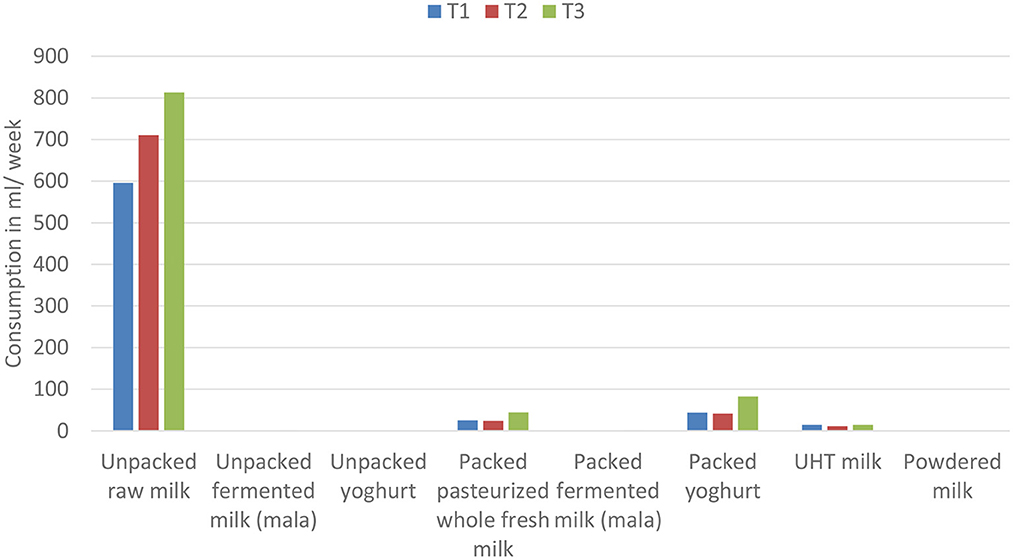
Figure 2. Average consumption of dairy products of children 6–48 months per week, by income groups. T1 = Group with lowest income of <100 USD/ month, T2 = Middle group with an income between 101 and 200 USD per month, T3 = Wealthiest group with an income between 201 and 300 USD/month.
In this study, as presented in Table 6, unprocessed products were the ones consumed in higher amounts by children. The amounts consumed declined as the level of processing of the product increased. It also decreased with declining household monthly income as shown in Figure 2. Unpacked milk was the most consumed type of dairy, and it was drunk by 98.7% of children during the 7 days previous to our visit. This is in line with the reported purchase pattern of 98.5% of the households interviewed.
Finally, from the study results demonstrated in the household's purchase and children's consumption patterns, it is evident that informal markets play a key role in meeting low-income household milk and dairy product demand. They offer affordability and easy access to an important food item that would otherwise be inaccessible given the effect of prices and household budgetary constraints. Additionally, informal markets offer a source of livelihood to smallholder actors from the rural areas (production end) to the urban markets (vendors) (Apaassongo et al., 2016). Previous studies have, however, assessed risk and reported various food safety concerns in these informal dairy markets in developing economies, such as Kenya (Zyl et al., 2006; Grace et al., 2010; ILRI, 2012; Grace, 2013; Lapar et al., 2014). They proposed various approaches that can address such concerns (Grace et al., 2014; Lapar et al., 2014; Johnson et al., 2015). Formulating effective dairy policies, therefore, require a broader understanding of the interlinkages within these parameters and identifying how to strengthen food markets without triggering unintended negative effects in other aspects of food security.
4. Conclusions and policy implications
This study sought to reveal insights into households' dairy purchase and consumption patterns, focusing on milk from informal markets. It also aimed at characterizing determinants of those purchase patterns, and how such determinants influence quantities of milk available to be feed to children below the age of 4 years. Data on consumption patterns of the various types of milk and milk products by children can inform interventions that target the health and nutrition status of children. It can also be used to estimate market needs for the different milk products, information relevant to governments, producers, processors and retailers.
We hypothesized that the choice and quantities of dairy purchased by the households is influenced by socioeconomic and demographic characteristics of the households. In line with other studies conducted in similar contexts, the study confirmed this hypothesis and identified as positive determinants of quantity of milk purchased the budget allocated to animal sourced food, the number of children below 4 years living in the household, the age of the household head and education level of the spouse. The quantity purchased from formal markets within the same period negatively affected the amount purchased from informal market.
Beyond the demographic drivers of quantity purchased, this study showed that the lower the income of the households, the less diversity of dairy products purchased. Other factors like household size and price of commodity – which is higher for industrially processed products – are factors that are associated with lower milk purchase. The price of informal dairy products negatively and significantly affected the quantity purchased.
Looking at the consumption patterns of children, this study shows that informal markets play a key role in nutritional requirements of children. However, the consumption is still below the recommended amounts of at least 2 cups of milk a day. The findings also show that majority do not consume as milk but as an ingredient in other food items, hence lowering the quantities of milk consumed by children. These are key areas for policy consideration when attempting to promote milk intake and support the development of the dairy sector in the country.
Given the clear association of income and milk intake, our results would call for the dairy sector, and food policies generally, to consider developing regulatory measures that are cost-oriented in order to minimize the price effect of commodities to low-income consumers, especially in urban set-ups where there is limited own production. Such measures include reducing or subsidizing inputs of production, providing financial credits along the nodes of the value chain that undertake processing, reducing tax of retail dairy products and promoting investment that improves general food safety and quality. This can potentially create price-resilient households hence shifting preference to other factors of demand.
4.1. Limitations of the study
The findings of this research should be interpreted accounting for its limitations. The selection criteria targeted households that purchased milk primarily from informal markets and have a child between 6 and 48 months. This limits the extent to which it is comparable to other studies and hence caution is required. Secondly, whereas the study was restricted to a specific region, it only provides an outlook of a peri-urban set up and the results apply in such context. For broader policy, a bigger sample size and study setting would be required to capture as much variability as possible. Thirdly, this was a cross-sectional survey using a 7-day recall period for purchase and consumption patterns. This may differ over a longer period given that there are other external factors like taste, cultural beliefs and perceived nutritional value of food that affect purchase and consumption patterns in a household faced with a budget constraint. For example, seasonality affects milk availability and hence prices, price of other animal sourced food items, age of children and school schedules. Further research is therefore required to untangle more drivers of purchase and consumption that would guide governments and stakeholders on interventions aiming at promoting dairy sector as a pathway to food security and safety.
Data availability statement
The datasets presented in this article are not readily available because the raw data can only be provided in anonymized form in line with affiliate institutional data management policy. Requests to access the datasets should be directed to EM, ZS5tdXVuZGFAY2dpYXIub3Jn.
Ethics statement
The studies involving human participants were reviewed and approved by the International Livestock Research Institute—Institutional Ethics Research Committee (ILRI-IREC2018-17). Permission to conduct the survey was also obtained from NACOSTI and the relevant local authorities. The patients/participants provided their written informed consent to participate in this study.
Author contributions
EM: methodology, software, formal analysis, investigation, and writing—original draft. NM: conceptualization, methodology, review, visualization, supervision, and funding acquisition. EB: supervision and writing—review and editing. FW: data curation. SA: conceptualization, resources, writing—review and editing, supervision, project administration, and funding acquisition. All authors contributed to the article and approved the submitted version.
Funding
This publication is based on research funded by the Bill and Melinda Gates Foundation and UK Aid from the UK government (Ref. OPP1156625). The work also received financial support from the CGIAR Research Program on Agriculture for Nutrition and Health. The findings and conclusions contained within are those of the authors and do not necessarily reflect positions or policies of the Bill & Melinda Gates Foundation or the UK government.
Acknowledgments
We extend our gratitude to our field enumerators Gideon Kiarie, Edwin Angwenyi, Grace Njoroge, and the community health volunteers for their contribution during the implementation of this work. We also remain grateful to the respondents from the Dagoretti whose information serves as the backbone of this research. We also acknowledge that parts of this work are obtained from a MSc thesis of the EM.
Conflict of interest
The authors declare that the research was conducted in the absence of any commercial or financial relationships that could be construed as a potential conflict of interest.
Publisher's note
All claims expressed in this article are solely those of the authors and do not necessarily represent those of their affiliated organizations, or those of the publisher, the editors and the reviewers. Any product that may be evaluated in this article, or claim that may be made by its manufacturer, is not guaranteed or endorsed by the publisher.
Supplementary material
The Supplementary Material for this article can be found online at: https://www.frontiersin.org/articles/10.3389/fsufs.2023.1084067/full#supplementary-material
Footnotes
1. ^Unpacked milk in this paper is used to refer to unprocessed milk at the time of selling. It does not mean that children consume the milk in raw form. Research shows that over 98% of households boil milk before consumption (Walke et al., 2014) or use as part of cooked dishes like tea and porridge (Grace and McDermott, 2015).
References
Agenbag, M., Lues, R., and Lues, L. (2012). Exploring policy compliance of the South African informal milk-producing segment. J Public Health Policy. 33, 230–243. doi: 10.1057/jphp.2011.59
Akbay, C., and Tiryaki, G. Y. (2007). Unpacked and packed fluid milk consumption patterns and preferences in Turkey. Agric. Econ. 38, 9–20. doi: 10.1111/j.1574-0862.2007.00226.x
Alonso, S., Muunda, E., Ahlberg, S., Blackmore, E., and Grace, D. (2018). Beyond food safety: socio-economic effects of training informal dairy vendors in Kenya. Glob Food Sec. 18, 86–92. doi: 10.1016/j.gfs.2018.08.006
Apaassongo, I. L., Aidoo, R., and Ohene-Yankyera, K. (2016). Securing safe food, order in cities and protected urban livelihoods: Modelling of preference for regulations of informal street food trade in Kumasi. World Develop. Perspect. 3, 16. doi: 10.1016/j.wdp.2016.10.003
Black, R. E., Williams, S. M., Jones, I. E., and Goulding, A. (2002). Children who avoid drinking cow milk have low dietary calcium intakes and poor bone health. Am J Clin Nutr. 76, 675–680. doi: 10.1093/ajcn/76.3.675
Bus, A. E. M., and Worsley, A. (2003). Consumers' health perceptions of three types of milk: a survey in Australia. Appetite. 40, 93–100. doi: 10.1016/S0195-6663(03)00004-7
Cornelsen, L., Alarcon, P., Häsler, B., Amendah, D. D., Ferguson, E., Fèvre, E. M., et al. (2016). Cross-sectional study of drivers of animal-source food consumption in low-income urban areas of Nairobi, Kenya. BMC Nutr. 2, 70. doi: 10.1186/s40795-016-0109-z
Cornelsen, L., Green, R., Turner, R., Dangour, A. D., Shankar, B., Mazzocchi, M., et al. (2015). What happens to patterns of food consumption when food prices change? Evidence from a systematic review and meta-analysis of food price elasticities globally. Health Econ. 24, 1548–1559. doi: 10.1002/hec.3107
Dominguez-Salas, P., Alarcón, P., Häsler, B., Dohoo, I. R., Colverson, K., Kimani-Murage, E. W., et al. (2016). Nutritional characterisation of low-income households of Nairobi: socioeconomic, livestock and gender considerations and predictors of malnutrition from a cross- sectional survey. BMC Nutr. 2, 1–20. doi: 10.1186/s40795-016-0086-2
Dror, D. K., and Allen, L. H. (2011). The importance of milk and other animal-source foods for children in low-income countries. Food Nutr Bull. 32, 227–243. doi: 10.1177/156482651103200307
Flax, V. L., Thakwalakwa, C., Schnefke, C. H., Phuka, J. C., and Jaacks, L. M. (2021). Food purchasing decisions of Malawian mothers with young children in households experiencing the nutrition transition. Appetite. 156, 104855. doi: 10.1016/j.appet.2020.104855
Gichohi, M. (2014). Status of the Kenyan dairy industry. In: ESADA's Breakfast meeting on 13th August, Nairobi, Kenya.
Grace, D., Domínguez-Salas, P., Alonso, S., Lannerstad, M., Muunda, E. M., Ngwili, N. M., et al. (2018). The Influence of livestock-Derived Foods on Nutrition During the First 1,000 Days of Life. Nairobi: International Livestock Research Institute (ILRI).
Grace, D., Makita, K., Kang'ethe, E. K., and Bonfoh, B. (2010). Safe food, fair food: Participatory risk analysis for improving the safety of informally produced and marketed food in sub Saharan Africa. Revue Africaine de Santé et de Productions Animales. 8, 311. Available online at: http://www.researchgate.net/publication/234073830_Safe_Food_Fair_Food_Participatory_Risk_Analysis_forimproving_the_safety_of_informally_produced_andmarketed_food_in_sub_Saharan_Africa
Grace, D., and McDermott, J. (2015). Food Safety: Reducing and Managing Food Scares 2014-2015 Global Food Policy Report. Washington, DC: International Food Policy Research Institute, 41–50.
Grace, D., Roesel, K., and Lore, T. (2014). Food safety in informal markets in developing countries: Lessons from research by the International Livestock Research Institute. (ILRI Research Brief 20). Nairobi: International Livestock Research Institute.
Grace, D., Roesel, K., Kangethe, E, Bonfoh, B, and Theis, S. (2015). Gender roles and food safety in 20 informal livestock and fish value chains. IFPRI. 11, 1489. doi: 10.2139/ssrn.2741313
Grwambi, B. (2021). “Food safety and food security in the informal sector,” in Food Security in Africa (IntechOpen). doi: 10.5772/intechopen.91012
ILRI. (2012). Food Safety in Sub-Saharan Africa ILRI / BMZ Safe Food Fair Food Informal Markets Why Informal Sector? How We Deal With Informal Marketing? Food Safety Risk Analysis Participants Discuss. ILRI.
Johnson, N., Mayne, J. R., Grace, D., and Wyatt, A. J. (2015). How Will Training Traders Contribute to Improved Food Safety in Informal Markets for Meat and Milk? A Theory of Change Analysis. Available online at: http://papers.ssrn.com/abstract=2685229
Kaitibie, S., Omore, A. O., Rich, K., and Kristjanson, P. (2010). Kenyan dairy policy change: influence pathways and economic impacts. World Dev. 38, 1494–1505. doi: 10.1016/j.worlddev.2010.06.008
Kangethe, E, Grace, D, Alonso, S, Lindahl, J, Mutua, F, and Haggblade, S. (2020). “Food safety and public health implications of growing urban food markets,” in AGRA, Africa Agriculture Status Report Feeding Africa's cities: Opportunities, Challenges, and Policies for Linking African Farmers With Growing Urban Food Markets. Nairobi, Kenya: Alliance for a Green Revolution in Africa (AGRA), 101–19.
KDB. (2022). Milk intake 2001-2016. General Information. Available online at: http://www.kdb.co.ke/contact/milk-intake-2001-2016 (accessed May 14, 2022).
Lapar, L., Deka, R., Lindahl, J., and Grace, D. (2014). “Quality and safety improvements in informal milk markets and implications for food safety policy,” in Paper Presented at 8th International Conference of the Asian Society of Agricultural Economists (Savar).
Leksmono, C., Young, J., Hooton, N., Muriuki, H. G., and Romney, D. (2006). Informal Traders Lock Horns With the Formal Milk Industry: The Role of Research in Pro-Poor Dairy Policy Shift in Kenya. ODI Working Paper, 266. Available online at: http://kms1.isn.ethz.ch/serviceengine/Files/ISN/95717/ipublicationdocument_singledocument/90e8596d-c4c5-4d1e-9965-0a3b39705956/en/wp266.pdf
Lönnerdal, B. (2003). Nutritional and physiologic significance of human milk proteins. Am J Clin Nutr. 77, 1537S–1543S. doi: 10.1093/ajcn/77.6.1537S
MoALF (2013). The National Dairy Development Policy. Nairobi, Kenya; 2013. (Sessional Paper). Report No.: 5.
Muunda, E., Mtimet, N., Schneider, F., Wanyoike, F., Dominguez-Salas, P., Alonso, S., et al. (2021). Could the new dairy policy affect milk allocation to infants in Kenya? A best-worst scaling approach. Food Policy. 101, 102043. doi: 10.1016/j.foodpol.2021.102043
Nyokabi, S., Luning, P. A., de Boer, I. J. M., Korir, L., Muunda, E., Bebe, B. O., et al. (2021). Milk quality and hygiene: Knowledge, attitudes and practices of smallholder dairy farmers in central Kenya. Food Control. 130, 108303. doi: 10.1016/j.foodcont.2021.108303
Rademaker, C. J., Omedo Bebe, B., van der Lee, J., Kilelu, C., and Tonui, C. (2016). Sustainable Growth of the Kenyan Dairy Sector : A Quick Scan of Robustness, Reliability and Resilience. Wageningen: Wageningen University and Research.
Roesel, K., and Grace, D. (2014). Food Safety and Informal Markets: Animal Products in Sub-Saharan Africa, 1st Edn. London: Routledge.
Schneider, F. (2018). Assessing the Effects of Policy Change on Households and Children's Milk Consumption in Peri-Urban. Nairobi, Kenya: University of Hohenheim.
Sichilima, T., Mapemba, L., and Tembo, G. (2015). What determines expenditure allocation to beef among lusaka residents in Zambia? evidence from household survey. Modern Econ. 6, 411–422. doi: 10.4236/me.2015.63039
Walke, M., Mtimet, N., Baker, D., Lindahl, J., Hartmann, M., Grace, D., et al. (2014). “Kenyan perceptions of aflatoxin: An analysis of raw milk consumption,” in Paper Prepared for Presentation at the EAAE 2014 Congress ‘Agri-Food and Rural Innovations for Healthier Societies. Ljubljana, Slovenia.
Wham, C. A., and Worsley, A. (2003). New Zealanders' attitudes to milk: implications for public health. Public Health Nutr. 6, 73–78. doi: 10.1079/PHN2002353
Yayar, R. (2012). Consumer characteristics influencing milk consumption preference. The Turkey case. Theor. Appl. Econom. 19, 2552. Available online at: https://econpapers.repec.org/article/agrjournl/v_3a7(572)_3ay_3a2012_3ai_3a7(572)_3ap_3a25-52.htm
Zyl, E. L., van, Mccrindle, C. M. E., and Grace, D. (2006). Participatory Risk Assessment for Food Safety in Informal Markets. Available online at: http://icomst-proceedings.helsinki.fi/papers/2008_02_25.pdf
Keywords: informal markets, Kenya dairy, milk, purchase, consumption, OLS
Citation: Muunda E, Mtimet N, Bett E, Wanyoike F and Alonso S (2023) Milk purchase and consumption patterns in peri-urban low-income households in Kenya. Front. Sustain. Food Syst. 7:1084067. doi: 10.3389/fsufs.2023.1084067
Received: 29 October 2022; Accepted: 25 January 2023;
Published: 17 February 2023.
Edited by:
Delia Grace, University of Greenwich, United KingdomReviewed by:
Francis Butler, University College Dublin, IrelandTonna Ashim Anyasi, Agricultural Research Council of South Africa (ARC-SA), South Africa
Copyright © 2023 Muunda, Mtimet, Bett, Wanyoike and Alonso. This is an open-access article distributed under the terms of the Creative Commons Attribution License (CC BY). The use, distribution or reproduction in other forums is permitted, provided the original author(s) and the copyright owner(s) are credited and that the original publication in this journal is cited, in accordance with accepted academic practice. No use, distribution or reproduction is permitted which does not comply with these terms.
*Correspondence: Emmanuel Muunda,  ZS5tdXVuZGFAY2dpYXIub3Jn
ZS5tdXVuZGFAY2dpYXIub3Jn
 Emmanuel Muunda
Emmanuel Muunda Nadhem Mtimet
Nadhem Mtimet Eric Bett
Eric Bett Francis Wanyoike1
Francis Wanyoike1 Silvia Alonso
Silvia Alonso
